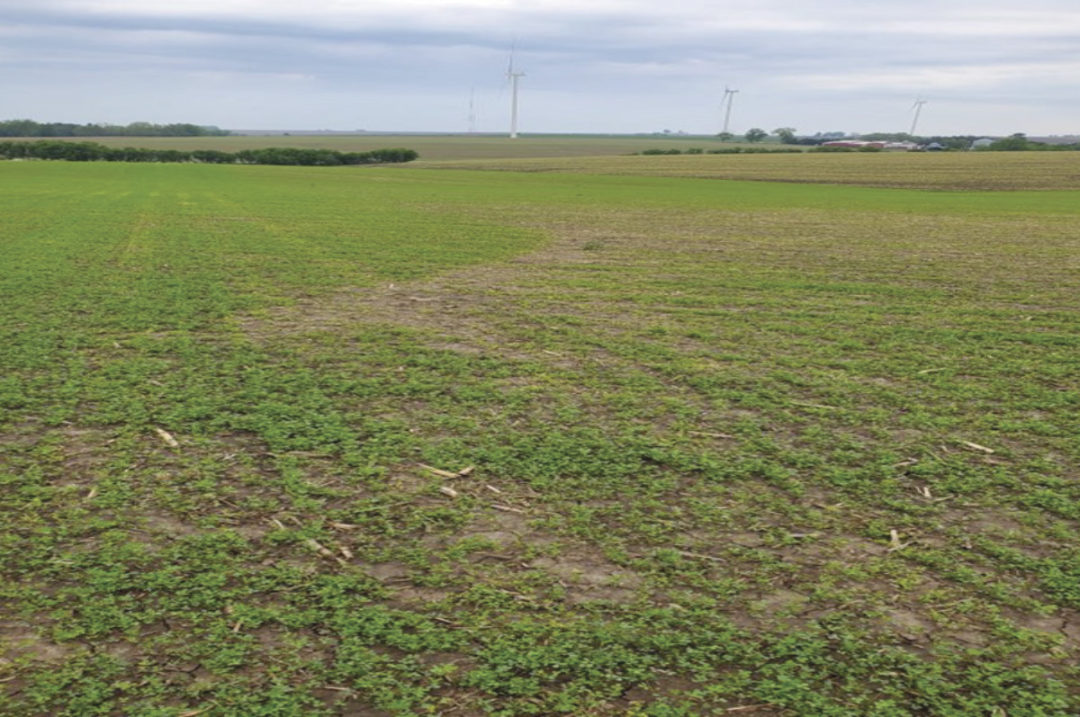The most effective weed control programs for summer annual weeds in many crops include herbicides that deliver long-lasting, residual weed control. However, these herbicides can carry over into the next year and reduce alfalfa stand establishment if one is not careful.
Herbicide soil persistence (residual life) is the length of time a herbicide remains active in a soil. Quantity of herbicide residuals in the soil depends on moisture and microbial activity to break herbicides down. So one of the consequences of a drier-than-average growing season (in 2023) is that the herbicides applied may still be active into the following season (2024). Herbicide residuals have been a significant cause of alfalfa stand failures.
Herbicides may be taken up by plants and metabolized, photodecomposed on the soil or plant surface, or lost to surface runoff. Each of these factors reduce herbicide residuals.
The following factors affect herbicide persistence in the soil:
- Microbial decomposition is one of the most important causes of herbicide decomposition in soil. Soil microorganisms metabolize herbicides either aerobically (with oxygen) or anaerobically (without oxygen). Often, soil microbes use the herbicide molecules as an energy source. The microbial population levels and activity depend on food supply, temperature, soil moisture, oxygen, soil pH and organic matter content. The optimum temperature for microbial activity generally is 80ºF to 90°F. The rate of microbial herbicide breakdown declines with falling temperatures and virtually ceases as soil temperatures drop below 40°F.
- Chemical decomposition by nonbiological processes is common for some herbicides. Oxidation-reduction reactions involve the transfer of electrons from the herbicide molecule to another molecule. Hydrolysis is a process in which the herbicide molecules react with water; usually, chemical bonds in the herbicide molecule are broken and one or more atoms in the herbicide molecule are replaced by hydroxyl ions (OH-) from water. Hydrolysis may change the molecular structure and inactivate the herbicide.
- Soil adsorption can make herbicides unavailable for uptake by plants by the adhesion of herbicide molecules to the surface of soil particles. Soil adsorption of herbicides occurs mainly on either clay or humus fractions. Herbicides generally are more tightly adsorbed in dry soils than in wet soils.
- Volatilization is the vaporization of an herbicide to a gaseous form. Herbicide volatilization increases as the temperature rises. Most volatilization occurs when the herbicide is either on the plant or soil surface. Very little volatilization occurs once the herbicide is mixed into the soil either by mechanical incorporation or rainfall.
- Leaching is the movement of herbicides through soil by water. When an herbicide is leached downward, the concentration of herbicide near the soil surface is reduced, lessening the chances for herbicide carryover problems. (However, leaching may cause environmental problems.) Leaching is greater in coarse-textured soils (sandy loams, etc.) than in finer-textured soils (clay loams, etc.) and is limited by lack of rainfall and by compaction layers. The potential of an herbicide to leach is determined by its water solubility and soil adsorption.
One should check herbicides used last year on fields where the intent is to plant alfalfa in 2024. Herbicide rotation interval recommendations for alfalfa are shown in Tables 1 and 2 for a number of herbicides.


The main contributors to herbicide residue carryover are poor herbicide uptake by intended crop plants and limited microbial or chemical degradation of herbicides in dry soil conditions. Since many regions of the U.S. suffered some degree of drought last year, farmers should be extremely cautious about herbicide history of fields where seeding alfalfa. In addition to reduced stand establishment as shown in the picture, alfalfa plants may also be stunted and more susceptible to diseases and insects.
If concerned about herbicide carryover, one might consider deep tillage which will dilute the herbicide residues into a larger volume of soil. Additionally, agronomic practices that encourage crop emergence quickly and promote good seedling growth will reduce effect of the herbicide residuals. These practices include starting with good soil fertility and pH, placing seed at proper depth and planting at optimum date when soil temperature is adequate for good alfalfa growth. Also, use alfalfa varieties with high disease resistance ratings and seed coated with the fungicides Apron and Stamina.
Lastly, choose herbicides with shorter residuals for crops grown in 2024 when intending to plant alfalfa in 2025.










